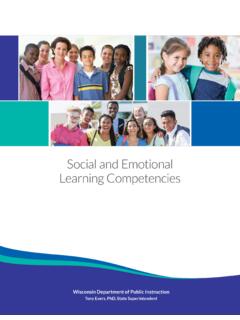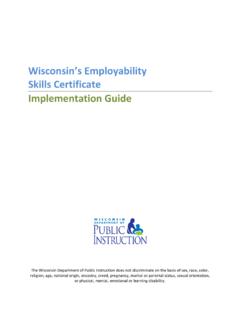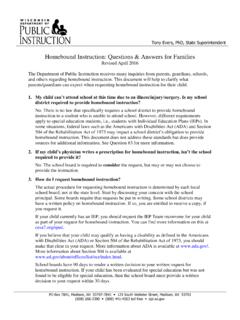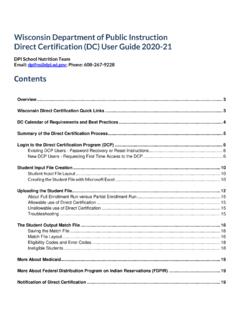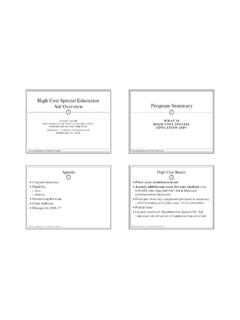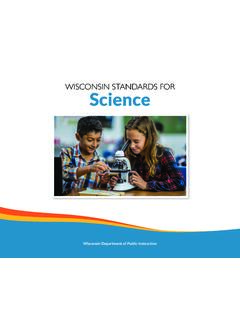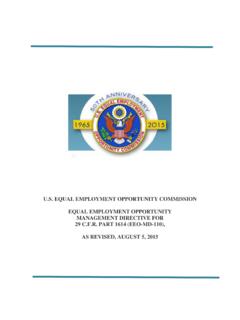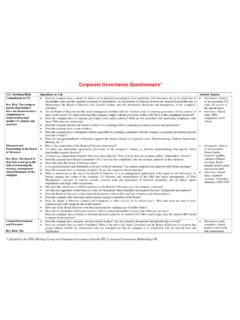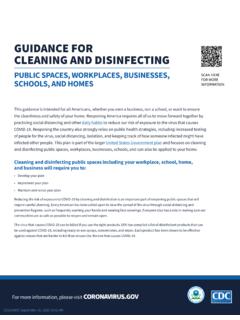Transcription of WISCONSIN DEPARTMENT OF PUBLIC INSTRUCTION …
1 Revised December 2019 1 WISCONSIN DEPARTMENT OF PUBLIC INSTRUCTION GUIDE TO SPECIAL EDUCATION FORMS Originally published September 2008 Last updated December 2019 INTRODUCTION Special education forms assist local educational agencies (LEA) and parents in implementing federal and state special education laws by guiding them through referring and evaluating students, developing individualized education programs (IEPs), and determining educational placements. Some forms assist in implementing other requirements, such as conducting a manifestation determination and determining the need for extended school year services. In addition, the forms serve as a LEA s primary documentation tool for demonstrating compliance with many of the requirements of federal and state special education laws and improving outcomes for students with disabilities.
2 Information about improving outcomes for students with disabilities under Results Driven Accountability (RDA) may be found at The information in this guide is intended to provide general guidance to assist LEA staff and parents in implementing requirements of federal and state special education law. It is not intended to provide student-specific legal advice. State special education law, Subchapter V of Chapter 115, and the Federal Individuals with Disabilities Education Act (IDEA), 34 CFR Parts 300 & 303, along with related information and materials for implementing federal and state special education requirements is available at The DEPARTMENT of PUBLIC INSTRUCTION s (DPI) special education forms (also translated in Spanish and Hmong) and this guide are available in hard copy by contacting the Special Education Team, DPI, Box 7841, Madison, WI 53707-7841; or accessing the DPI website at The terms child, child with a disability, and student are used interchangeably throughout the sample special education forms, this guidance, and the IDEA itself.
3 Revised December 2019 2 TABLE OF CONTENTS INTRODUCTION 1 Prior Written Notice 5 Timelines 7 Referral and Evaluation 11 R-1 Referral for Special Education Evaluation (Wis. Stat. ) 11 IE-1 Notice of Receipt of Referral and Start of Initial Evaluation 14 IE-2 Initial Evaluation: Notice that No Additional Assessments Needed 17 IE-3 Initial Evaluation: Notice and Consent Regarding Need to Conduct Additional Assessments 20 RE-1 Notice of Reevaluation 24 RE-2 Notice of Agreement to Conduct a Reevaluation More Than Once a Year 27 RE-3 Notice of Agreement that a Three-Year Reevaluation Not Needed 30 RE-4 Reevaluation: Notice that No Additional Assessments Needed 32 RE-5 Reevaluation: Notice and Consent Regarding Need to Conduct Additional Assessments 35 ED-1 Existing Data Review to Determine if Additional Assessments or Evaluation Data Are Needed 39 ER-1 Evaluation Report Including.
4 Determination of Eligibility and Need for Special Education 43 ER-2A Required Documentation for Specific Learning Disability (SLD) Initial Evaluation 51 ER-2B Required Documentation for Specific Learning Disability (SLD) Reevaluation 57 ER-2C Required Documentation for Specific Learning Disability (SLD) Initial Evaluation Using Significant Discrepancy 61 ER-3 Evaluation Report: Documentation for Determining Braille Needs for a Child with a Visual Impairment 66 ER-4 Notice of IEP Team Findings that Child Is Not a Child with a Disability 67 Arranging/Scheduling Individualized Education Program Meetings 69 I-1 Invitation to a Meeting of the Individualized Education Program Team (IEP) 69 Revised December 2019 3 I-1- A Request to Invite Outside Agency Representative(s) to the Individualized Education Program (IEP) Meeting 76 I-1- B Request to Invite Birth to 3 Program Representative(s) to the Initial Individualized Education Program (IEP) Meeting 78 I-1- C Request to Invite Others with Knowledge or Special Expertise to an Individualized Education Program (IEP)
5 Meeting 79 I-2 Agreement on IEP Team Participant Attendance at IEP Meeting 80 I-3 IEP Team Meeting Cover Page 83 Developing Individualized Education Programs 87 I-4 IEP: Linking Present Levels, Needs, Goals and Services Form 87 I-5 Annual Review of IEP Goals 107 I-6 Interim Review of IEP Goals 109 I-7 Statewide and District-wide Assessments 111 I-7- A Participation Guidance for Alternative Assessment 113 I-7 District-wide Assessment 115 I-7 ACCESS for ELLs /Alt. ACCESS for ELLs 118 I-7 The ACT with Writing and ACT WorkKeys 120 I-7 ACT ASPIRE Early High School 121 I-7 DLM 122 I-7 Forward 124 I-8 Summary of Transition Services 125 I-10 Notice of Changes to IEP without an IEP Meeting 128 I-11 Extended School Year 130 I-12 Manifestation Determination Review 131 DW-1 Worksheet for Documenting Educational Services Provided During Disciplinary Removals that Do Not Constitute a Disciplinary Change of Placement 133 Revised December 2019 4 Determining Placements 135 P-1 Determination and Notice of Placement.
6 Consent for Initial Placement 136 P-2 Determination and Notice of Placement 139 P-3 Notice of Graduation 142 P-4 Notice of Ending of Services Due to Age 144 P-5 Parent Revocation of Consent for Special Education 146 P-6 Notice of Cessation of Special Education and Related Services in Response to Parental Revocation of Consent 147 Miscellaneous 149 M-1 Notice of Response to an Activity Requested by a Parent 149 M-2 Notice of Agreement to Extend Time Limit to Complete Evaluation for Transfer Student 150 M-3 Agreement to Extend the Time Limit to Complete the Evaluation of a Child Suspected of Having a Specific Learning Disability 152 M-5 Consent to Bill WISCONSIN Medicaid for Medically-Related Special Education and Related Services 154 M-6 Notification of Upcoming Transfer of Rights 156 M-7 Student Notification of Transfer of Rights 157 M-8 Parent Notification of Transfer of Rights 158 Revised December 2019 5 Prior Written Notice Parents must be provided written notice a reasonable time before a LEA: proposes to initiate or change the identification, evaluation, or educational placement of a student or the provision of FAPE to the student; or refuses to initiate or change the identification, evaluation, or educational placement of a student or the provision of FAPE to the student.
7 (34 CFR [a]; Wis. Stat. [1][b]). Anytime written notice is required it must include: a description of the action proposed or refused by the LEA; an explanation of why the LEA proposes or refuses to take the action; a description of each evaluation procedure, assessment, record, or report the LEA used as a basis for the proposed or refused action; a description of any other options that the LEA considered and the reasons why those options were rejected; a description of other factors that are relevant to a LEA s proposal or refusal; a statement that parents have protection under the procedural safeguards of special education law and, if the notice is not an initial referral for evaluation, the means by which a copy of a description of the procedural safeguards can be obtained; and sources for parents to contact to obtain assistance in understanding the provisions of special education law.
8 (34 CFR [b]; Wis. Stat. [2]). Notices must be: written in language understandable to the general PUBLIC ; provided in the native language of the parent or other mode of communication of the parent, unless it is clearly not feasible to do so; and if the native language or other mode of communication of the parent is not a written language the LEA must take steps to ensure that (1) the notice is translated orally or by other means to the parent in his or her native language or other mode of communication, and (2) the parent understands the content of the notice. The LEA must maintain written evidence of having complied with the requirements in (1) and (2). (34 CFR [c]; Wis. Stat. [2]). NOTE: In the Sample Special Education forms for WISCONSIN , the prior written notice requirement is documented in a variety of forms, including, but not limited to, the Evaluation and Reevaluation Notices (IE-1 through IE-3 and RE-1 through RE-5), the Determination and Notice of Placement (P-1 or P-2), Notice of Graduation (P-3), Notice of Ending of Services Due to Age (P-4), Notice of Cessation of Special Education in Response to Parental Revocation of Consent (P-6), and Notice of Response to an Activity Requested by Parent (M-1).
9 Revised December 2019 6 When a student reaches the age of majority (age 18 in WISCONSIN ), the rights under special education law transfer to the student unless a guardian has been appointed. Model forms M-6, M-7, and M-8 provide the parent(s) and adult student with upcoming notice and notice of this transition (Wis. Stat. [3]). Consequently, when any of the above notices are sent to an adult student, the LEA should modify the language ( , changing your child or your student to you ). In addition, when any of these notices are sent to an adult student, a copy also must be sent to the student s parents. Revised December 2019 7 Timelines Evaluation At least annually, the LEA must inform parents and others required to make referrals about the LEA s referral and evaluation procedures (Wis. Stat. [3][d]). Notify the parent(s) in writing that a referral was received and of the start of the initial evaluation, or of initiating a reevaluation ( 34 CFR [a]; Wis.)
10 Stat. [1][b]). Within 15 business days of receiving a referral to evaluate a student, or initiating a reevaluation, the IEP team must complete its review of existing evaluation data and send the student s parents a request for consent to evaluate, or if no additional data are necessary, notify the parents of that determination. Business day means Monday through Friday except for Federal and State holidays. There are no legal exceptions or provisions for extension of the 15-business-day timeline ( Wis. Stat. [3][e]). Within 60 calendar days of receiving parent consent to evaluate, or informing parents that no additional assessment or evaluation data are needed, the LEA must complete its evaluation of the student and determine whether the student is or continues to be a child with a disability under IDEA (34 CFR [c]; Wis.
